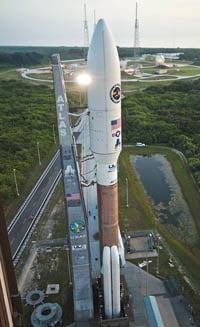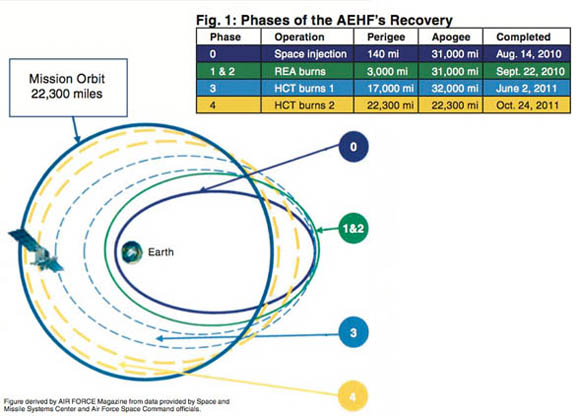Original URL: https://www.theregister.com/2012/01/04/aehf_system_rescue/
Space soldiers save satellite from FLAMING DEATH
The little engine that could rescues $2bn military bird
Posted in Science, 4th January 2012 01:41 GMT
The US Air Force Space Command's 14-month effort to save a $2bn military communications satellite overcame failed thrusters, threatened explosion, space debris, and destructive radiation, thanks in great measure to tiny thrusters with a mere 0.05 pounds of oomph.
It wasn't easy, as airforce-magazine.com reports in a blow-by-blow account of the rescue published in its January issue, which details for the first time exactly how close the mission came to costly catastrophe.
Space Vehicle-1 was launched on August 10, 2010, with the goal of placing the first satellite of the planned Advanced Extremely High Frequency (AEHF) system into orbit.
The AEHF system, described as having a primary mission of "near-worldwide, secure, survivable satellite communications" among military and civilian leaders and worldwide forces, is a 10X improvement over the current Milstar communications system, the first satellite of which was launched in 1994.
The first AEHF satellite, launched in 2010, was intended to orbit at 22,236 miles above the earth (give or take a hop, step, and a jump), the distance at which a satellite becomes geosynchronous – meaning that one orbit takes exactly as long as one earth day.
Traveling along above the equator – directly overhead the Galápagos Islands, to be exact – the satellite was intended to also be geostationary, meaning that its orbit would keep it above the same spot on earth, rather than wagging back and forth across the equator, which would have been the case had its orbit been at an angle to that mid-earth dividing line.
The launch of the Atlas V carrying SV-1 with its AEHF payload went off without a hitch, placing the 13,420-pound vehicle in its planned highly elliptical orbit, with an apogee of 31,000 miles and a perigee of 143 miles.
It wasn't intended to stay in that unstable orbit for long. The SV-1's propulsion system was scheduled to reduce its apogee and expand its perigee until it reached its eventual geosynchronous, geostationary parking place.
Problems, though, cropped up almost immediately. On August 15, the first firing of the vehicle's main propulsion system, the hydrazine-fueled liquid apogee engine (LAE), failed – the LAE shut down after only a few seconds. The space boffins gave it another go on August 17, with the same result. The LAE also also sent back telemetry that seemed to indicate that it was overheating.
Not good.
According to airforce-magazine.com, the command lead of the Military Satellite Communications Systems Directorate (MILSATCOM) at the Air Force Space Command (AFSPC), Michael Lakos, thought the second shutdown was "an Apollo 13 moment," since the vehicle needed the LAE to achieve its orbital goal. Over at the Space and Missile Systems Center (SMC) in Los Angeles, the head of MILSATCOM, David Madden, thought the mission was lost.
Madden then assembled a brain trust to determine what had gone wrong with the LAE – and fast. They quickly determined that a fuel-line blockage had cripped the engine. More importantly, they advised the vehicle's masters that to try to fire it up again could cause an explosion.
"They probably saved the satellite," Madden told airforce-magazine.com. "We could have had combustion outside of the engine, which could have either totally damaged our payload or caused catastrophic damage to the vehicle."
Another AFSPC boffin was more direct. "We're very, very fortunate that satellite didn't blow up," he said.
Enter the unrehearsed understudies
The team then sealed up the LAE's tanks, which had the advantage of safety but which also kept about 1,000 pounds of oxidizer bottled up, adding to the vehicle's weight.
With the LAE unusable, Madden and his team turned to the two other thrusters available to them: hydrazine-fueled reaction engines (REAs) and extremely low-thrust xenon-fueled Hall Current Thrusters (HCTs), which pumped out a miniscule 0.05 pounds of push.
If the comparatively powerful REAs could get the vehicle out of its unstable orbit relatively quickly, the HCTs – weak as they may be – had one tremendous advantage that could save the mission: they could be fired for thousands of hours with no ill effects.
The team needed to work fast, seeing as how the vehicle was losing about three miles of altutude per day, and its 140-mile-or-so perigee took it through a band of dangerous orbiting space junk. "That's a pretty nasty area," says Madden.
On August 29, the team fired up the REAs – which had been intended to stabilize the satellite, not change its orbital location – and by early September the vehicle had been nudged into a far safer perigee of 600 miles. By September 22, the perigee had risen to over 2,900 miles.
It was then the HTCs turn. One problem, however: the HTCs require electricity to operate, and at this altitude the vehicle was encountering radiation from the Van Allen Belts, radiation that could damage the satellite's solar-power panels, source of the HTCs' needed electricity.
The team plotted a course to get through the Van Allen Belts as quickly as possible – and they made it with little or no damage to the solar panels, which would be needed to power the AEHF satellite during its 14-year planned mission.
The HTCs continued firing, modifying the vehicle's orbit for 10 to 12 hours per day from October until the next June. Since they had never been intended for such use, Madden and his team continued to learn about their peccadilloes. "They're like a finicky old car," he said, "one that you’ve got to constantly adjust to get it to optimize. There’s no instruction manual for how to do that. It’s basically an art."
After boosting the perigee, the final step was to nudge the apogee down from its top altitude of 32,145 miles while continuing to boost the perigee up to the required geosynchronous altitude. The perigee reached its geosynchronous-altitude goal in early August, and the apogee matched it in on October 24.
At that point, the AEHF satellite was released from the SV-1, and an extensive "How y'doing?" checkout period of all its systems began. The Air Force now says that the communications satellite will be operational this March.
"All of the telemetry we're getting on the vehicle says we didn't violate any parameters," Madden says. "Our solar panels are doing great. We didn’t do any damage that would hurt us in full operation. We've got a full mission life planned for this vehicle."
SV-2 is planned for launch this April. Needless to say, there has been quite a bit of investigation of its LAE design since the SV-1's choked on August 17, 2010. ®

